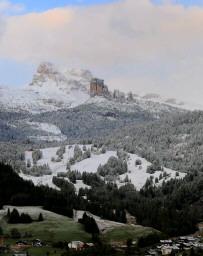The Paneveggio forest, smack in the middle of Italy's stunning Dolomite mountain range, holds a precious resource: its Norway spruce trees have been producing top quality resonance wood for cellos, violins and pianos for centuries.
Violinmakers since the legendary crafter of stringed instruments Antonio Stradivari in the seventeenth century have praised the wood's unflawed, compact and uniform density.
Only trees grown in optimal conditions and an unchanging mountain climate have the very narrow growth rings needed to produce wood capable of transmitting pure, harmonious sound waves.
Musicians and musical instrument makers still visit the forest at the foot of the Pale di San Martino to select their trees, just as Stradivari did hundreds of years ago.
Part of the Paneveggio-Pale di San Martino Nature Park, the Paneveggio forest is part of the Fiemme valley where historic workshops still make pianos and musical instruments using this special wood.
Selecting the trees, usually more than 200 years old, takes an uncanny ability and exceptional knowledge of the raw material and the soundboards made from these majestic Norway spruce.
The Magnifica Comunita' di Fiemme, an ancient form of self government in this Trento valley, still manages a large part of the local forests, strictly overseeing and controlling the certification of the wood and the correct management of the forest.
Every year, in a joint initiative with the Trento tourism agency, the community dedicates trees to imminent musicians performing in the Sounds of the Dolomites summer music festival.
The 'Woods that Play' project underscores the link between the forest and music, between the resonance wood trees and the musicians and composers whose creative genius contributes to the fame of this prized material.
The first musician to select 'his' tree was violinist Uto Ughi: after walking through the forest playing a few passages on his precious Stradivari violin, the maestro, listening to the notes vibrate in the fibres of a nearby tree, exclaimed ''It's this one! I want this one''.
A sign was erected next to the tree expressing the forest's gratitude: ''The trees in this forest vibrated to his magical harmonies. Thank you, Maestro Ughi''.
Veneto cellist Mario Brunello, after playing for an audience of more than a thousand people at a Dolomite Dawn concert, also let himself be guided by the sound of the trees.
The sign next to the spruce where he placed his cello and played that morning reads, ''Nature made us, man's genius discovered the power of our sound''.
Italian pianist Giovanni Allevi selected a tree after the debut performance of his '300 Rings' in the Paneveggio Forest for an audience of four thousand spectators.
''I chose the tallest one with the thickest crown, like me'', said Allevi.
English violinist Daniel Hope selected a tree in the most panoramic spot in the forest; ''I wanted a tree with sun on it from dawn to dusk'', explained Hope.
This year a tree will be dedicated to the violinist Giuliano Carmignola, who is scheduled to open the 15th edition of The Sounds of the Dolomites festival on July 3, performing with the Sonatori della Gioiosa Marca.
Italy has applied to the United Nations Educational Scientific and Cultural Organisation (UNESCO) for the Dolomites to be added to its World Heritage List.
The 2008 bid was endorsed this May by the International Union for the Conservation of Nature, the World Heritage Committee's advisory body on natural sites.
The committee's final verdict is expected by the end of June. Nine mountain groups, including the Pale di San Martino, have been selected as representative of two UNESCO criteria: superlative natural phenomena and outstanding examples representing major stages of earth's history.
Dolomites-Unesco: The forest of violins, 'Stradivari wood'
